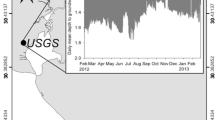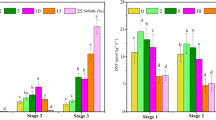Abstract
Denitrification is an important N removal process in aquatic systems but is also implicated as a potential source of global N2O emissions. However, the key factors controlling this process as well as N2O emissions remain unclear. In this study, we identified the main factors that regulate the production of net N2 and N2O in sediments collected from rivers with a large amount of sewage input in the Taihu Lake region. Net N2 and N2O production were strongly associated with the addition of NO3 −-N and NH4 +-N. Specifically, NO3 −-N controlled net N2 production following Michaelis–Menten kinetics. The maximum rate of net N2 production (V max) was 116.3 μmol N2-N m−2 h−1, and the apparent half-saturation concentration (k m) was 0.65 mg N L−1. N2O to N2 ratios increased from 0.18 ± 0.03 to 0.68 ± 0.16 with the addition of NO3 −-N, suggesting that increasing NO3 −-N concentrations favored the production of N2O more than N2. The addition of acetate enhanced net N2 production and N2O to N2 ratios, but the ratios decreased by about 59.5 % when acetate concentrations increased from 50 to 100 mg C L−1, suggesting that the increase of N2O to N2 ratios had more to do with the net N2 production rate rather than acetate addition in this experiment. The addition of Cl− did not affect the net N2 production rates, but significantly enhanced N2O to N2 ratios (the ratios increased from 0.02 ± 0.00 to 0.10 ± 0.00), demonstrating that the high salinity effect might have a significant regional effect on N2O production. Our results suggest that the presence of N-enriching sewage discharges appear to stimulate N removal but also increase N2O to N2 ratios.





Similar content being viewed by others
References
Akunna JC, Bizeau C, Moletta R (1993) Nitrate and nitrite reductions with anaerobic sludge using various carbon-sources-glucose, glycerol, acetic-acid, lactic-acid and methanol. Water Res 27(8):1303–1312
Arango CP, Tank JL, Schaller JL, Royer TV, Bernot MJ, David MB (2007) Benthic organic carbon influences denitrification in streams with high nitrate concentration. Freshw Biol 52:1210–1222
Baxter AM, Johnson L, Royer T, Leff LG (2013) Spatial differences in denitrification and bacterial community structure of streams: relationships with environmental conditions. Aquat Sci 75:275–284
Beaulieu JJ, Tank JL, Hamilton SK, Wollheim WM, Hall RO, Mulholland PJ et al (2010) Nitrous oxide emission from denitrification in stream and river networks. Proc Natl Acad Sci 108:214–219
Bernhard AE, Landry ZC, Blevins A et al (2010) Abundance of ammonia-oxidizing archaea and bacteria along as estuarine salinity gradient in relation to potential nitrification rates. Appl Environ Microbiol 76:1285–1289
Bernot MJ, Tank JL, Royer TV, David MB (2006) Nutrient uptake in streams draining agricultural catchments of the midwestern United States. Freshw Biol 51:499–509
Colt J (1984) Computation of dissolved gas concentrations in water as functions of temperature, salinity, and pressure. Special Publication No. 14. American Fisheries Society, Bethesda
Crutzen PJ (1970) Influence of nitrogen oxides on atmospheric ozone content. Q J R Meteorol Soc 96(408):320–325
Čuhel J, Šimek M, Laughlin RJ, Bru D, Chėneby D, Eatson CJ, Philipot L (2010) Insights into the effect of soil pH on N2O and N2 emissions and denitrifier community size and activity. Appl Environ Microbiol 76(6):1870–1878
Fulweiler RW, Nixon SW (2012) Net sediment N2 fluxes in a southern New England estuary: variations in space and time. Biogeochemistry 111:111–124
García-Ruiz R, Pattinson SN, Whitton BA (1998) Denitrification in sediments of the freshwater tidal Yorkshire Ouse. Sci Total Environ 210:321–327
Herrman KS, Bouchard V, Moore RH (2008) Factors affecting denitrification in agricultural headwater streams in Northeast Ohio, USA. Hydrobiologia 598:305–314
Hu Z, Zhang J, Li S, Xie H (2013) Impact of carbon source on nitrous oxide emission from anoxic/oxic biological nitrogen removal process and identification of its emission sources. Environ Sci Pollut Res 20:1059–1069
Hwang S, Jang K, Jang H, Song J, Bae W (2006) Factors affecting nitrous oxide production: a comparison of biological nitrogen removal processes with partial and complete nitrification. Biodegradation 17:19–29
Inwood SE, Tank JL, Bernot MJ (2005) Patterns of denitrification associated with land use in 9 midwestern headwater streams. J N Am Benthol Soc 24(2):227–245
Inwood SE, Tank JL, Bernot MJ (2007) Factors controlling sediment denitrification in midwestern streams of varying land use. Microb Ecol 53:247–258
IPCC (2001) Climate change 2001: the scientific basis. Cambridge University Press, Cambridge
Kana TM, Darkangelo C, Hunt MD, Oldham JB, Bennett GE, Cornwell JC (1994) Membrane inlet mass spectrometer for rapid high-precision determination of N2, O2, and Ar in environmental water samples. Anal Chem 66:4166–4170
Knowles R (1982) Denitrification. Microbiol Rev 46:43–70
Laverman AM, Garnier JA, Mounier EM, Roose-Amsaleg CL (2010) Nitrous oxide production kinetics during nitrate reduction in river sediments. Water Res 44:1753–1764
Li Q, Li P, Zhu P, Wu J, Liang S (2008) Effects of exogenous organic carbon substrates on nitrous oxide emissions during the denitrification process of sequence batch reactors. Environ Eng Sci 25:1221–1228
Li X, Xia Y, Li Y, Kana TM, Kimura SD, Saito M, Yan X (2013) Sediment denitrification in waterways in a rice-paddy-dominated watershed in eastern China. J Soil Sediment 13:783–792
Magalhães CM, Joye SB, Moreira RM, Wiebe WJ, Bordalo AA (2005) Effect of salinity and inorganic nitrogen concentrations on nitrification and denitrification rates in intertidal sediments and rocky biofilms of the Douro River estuary, Portugal. Water Res 39:1783–1794
Manconi I, Van der Maas P, Lens P (2006) Effect of copper dosing on sulfide inhibited reduction of nitric and nitrous oxide. Nitric Oxide 15:400–407
Moore TA, Xing YP, Lazenby B, Lynch MDJ, Schiff S, Robertson WD, Timlin R, Lanza S, Ryan MC, Aravena R, Fortin D, Clark ID, Neufeld JD (2011) Prevalence of anaerobic ammonium oxidizing bacteria in contaminated groundwater. Environ Sci Technol 45:7217–7225
Mulder A, Vandegraaf AA, Robertson LA, Kuenen JG (1995) Anaerobic ammonium oxidation discovered in a denitrifying fluidized-bed reactor. FEMS Microbiol Ecol 16:177–183
Naqvi SWA, Yoshinari T, Jayakumar DA, Altabet MA, Narvekar RV, Devol AH, Brande JA, Codispoti LA (1998) Budgetary and biogeochemical implications of N2O isotope signatures in the Arabian Sea. Nature 394:462–464
Naqvi SWA, Jayakumar DA, Narvekar PV, Naik H, Sarma VVSS, Dsouza W, Joseph S, George MD (2000) Increased marine production of N2O due to intensifying anoxia on the Indian continental shelf. Nature 408:346–349
Nielsen M, Gieseke A, de Beer D, Revsbech NP (2009) Nitrate, nitrite, and nitrous oxide transformations in sediments along a salinity gradient in the Weser Estuary. Aquat Microb Ecol 55:39–52
Pfenning KS, McMahon PB (1996) Effect of nitrate, organic carbon, and temperature on potential denitrification rates in nitrate-rich riverbed sediments. J Hydrol 187:283–295
Qin B, Xu P, Wu Q, Luo L, Zhang Y (2007) Environmental issues of Lake Taihu, China. Hydrobiologia 581:3–14
Royer TV, Tank JL, David MB (2004) Transport and fate of nitrate in headwater agricultural streams in Illinois. J Environ Qual 33:1296–1304
Seitzinger SP (1988) Denitrification in freshwater and coastal marine ecosystems: ecological and geochemical significance. Limnol Oceanogr 33:702–724
Senga Y, Mochida K, Fukumori R, Okamoto N, Seike Y (2006) N2O accumulation in estuarine and coastal sediments: the influence of H2S on dissimilatory nitrate reduction. Estuar Coast Shelf Sci 67:231–238
Silvennoinen H, Liikanen A, Torssonen J, Stange CF, Martikainen PJ (2008) Denitrification and nitrous oxide effluxes in boreal, eutrophic river sediments under increasing nitrate load: a laboratory microcosm study. Biogeochemistry 91:105–116
Smith LK, Voytek MA, Böhlke JK, Harvey JW (2006) Denitrification in nitrate-rich streams: application of N2: Ar and 15 N-tracer methods in intact cores. Ecol Appl 16(6):2191–2207
Teixeira C, Magalhaes C, Boaventura RAR, Bordalo AA (2010) Potential rates and environmental controls of denitrification and nitrous oxide production in a temperate urbanized estuary. Mar Environ Res 70:336–342
Teixeira C, Magalhaes C, Joye SB, Bordalo AA (2013) The role of salinity in shaping dissolved inorganic nitrogen and N2O dynamics in estuarine sediment-water interface. Mar Pollut Bull 66:225–229
Terry RE, Tate RL, Duxbury JM (1981) The effect of flooding on nitrous oxide emissions from an organic soil. Soil Sci 132:228–232
Wang S, Liu C, Yeager KM, Wan G, Li J, Tao F, Lü Y, Liu F, Fan C (2009) The spatial distribution and emission of nitrous oxide (N2O) in a large eutrophic lake in eastern China: anthropogenic effects. Sci Total Environ 407:3330–3337
Weiss RF (1970) The solubility of nitrogen, oxygen and argon in water and seawater. Deep Sea Res. Oceanogr Abstract 17:721–735
Weymann D, Geistlinger H, Well R, von der Heide C, Flessa H (2010) Kinetics of N2O production and reduction in nitrate-contaminated aquifer inferred from laboratory incubation experiments. Biogeosciences 7:1953–1972
Wu G, Zhai X, Jiang C, Guan Y (2013) Effect of ammonium on nitrous oxide emission during denitrification with different electron donors. J Environ Sci-China 25(6):1131–1138
Wunderlin P, Mohn J, Joss A, Emmenegger L, Siegrist H (2012) Mechanisms of N2O production in biological wastewater treatment under nitrifying and denitrifying conditions. Water Res 46:1027–1037
Xia Y, Li Y, Li X, Guo M, She D, Yan X (2013) Diurnal pattern in nitrous oxide emissions from a sewage-enriched river. Chemosphere 92:421–428
Zang XP, Wu GP, Tu M (2009) Algae bloom control countermeasures for the lakes and reservoirs in the Yangtze Basin. Yangtze River 40:5–8 (in Chinese)
Zhao YQ, Xia YQ, Kana TM, Wu YC, Li XB, Yan XY (2013) Seasonal variation and controlling factors of anaerobic ammonium oxidation in freshwater river sediments in the Taihu Lake region of China. Chemosphere 92:2124–2131
Zhou Y, Lim M, Harjono S, Ng WJ (2012) Nitrous oxide (N2O) emission by denitrifying phosphorus removal culture using polyhydroxyalkanoates (PHA) as carbon source. J Environ Sci. doi:10.1026/S1001-0742(11)60996-0
Acknowledgments
This work was financially supported by the Knowledge Innovation Program of the Chinese Academy of Sciences (No. KZCX2-YW-GJ01) and the Natural Science Foundation of China (Nos. 41071196 and 41061140515).
Author information
Authors and Affiliations
Corresponding author
Additional information
Responsible editor: Hailong Wang
Rights and permissions
About this article
Cite this article
Zhao, Y., Xia, Y., Li, B. et al. Influence of environmental factors on net N2 and N2O production in sediment of freshwater rivers. Environ Sci Pollut Res 21, 9973–9982 (2014). https://doi.org/10.1007/s11356-014-2908-6
Received:
Accepted:
Published:
Issue Date:
DOI: https://doi.org/10.1007/s11356-014-2908-6




